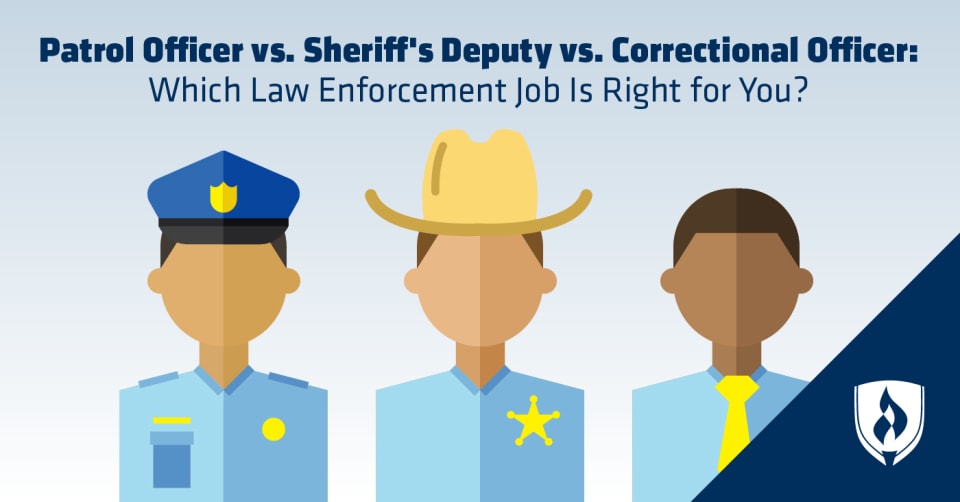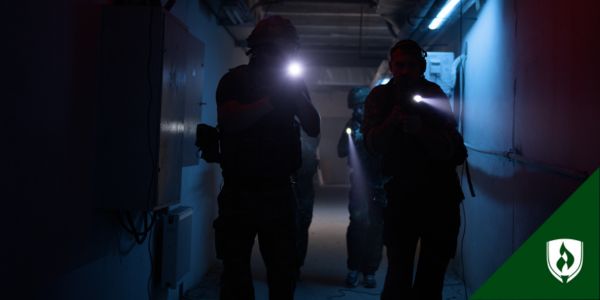Patrol Officer vs. Sheriff's Deputy vs. Correctional Officer: Which Law Enforcement Job is Right for You?
By Brianna Flavin on 08/16/2017

If you’ve ever asked a group of kids what they’d like to be when they grow up, you probably heard one or two excitedly answer, “Police officer!” What you probably didn’t hear was their detailed intentions to become a correctional officer, patrol officer or sheriff’s deputy. These jobs—and the differences between them—aren’t typically common knowledge even though they all fall under the law enforcement umbrella. And indeed, the term “police officer” can refer to many different job titles.
Maybe you are considering “keeping the peace” as a career path. If you feel a ripple of excitement picturing yourself with an officer’s badge or climbing into the driver’s seat of a cop car, you’ll need a more specific breakdown of the entry-level law enforcement job titles out there.
While you’re probably not job hunting just yet, it’s always helpful to have a clear understanding of the jobs that will be available once you start. These three entry-level positions are great choices to work as a peace-keeper. But what do these careers really look like? Read on to find out more.
Police patrol officer
Police patrol officers are sometimes referred to as “beat cops”. These professionals handle a variety of tasks, including the pursuit and arrest of perpetrators, emergency and traffic accident response, and the general enforcement of motor vehicle and criminal laws.
The biggest difference between a police officer and a sheriff’s deputy is their jurisdictional authority. Police jurisdiction begins and ends at the boundaries of the municipality it serves. This boundary might be a city, a town or a county, whatever the specifics of the municipality are. Police officers patrol the area in their jurisdiction, though they can also act outside their jurisdiction in the right circumstances.
Requirements
Most police patrol officer positions require training in a vocational school or an Associate’s degree. Candidates for these roles typically attend a certified training academy before becoming an officer. These training academies will involve both classroom instruction and skills training. It’s important to ensure your program of choice adheres to state requirements.
Job outlook
Police patrol officers are in higher demand generally than sheriff’s deputies or correctional officers. There were 5,738 job openings for patrol officers posted online in 2016, and the BLS reports that job opportunities will be greater in cities and areas with large populations.1
Candidates looking to stand out from the competition may want to consider pursuing a Bachelor’s degree. Being able to speak a second language can also be a big plus for police departments that serve diverse communities.
Sheriff’s deputy
Sheriff’s deputies investigate illegal or suspicious activity, patrol roads to detect law violators, take control of collision scenes, and assist collision victims. The role is very similar to that of a police patrol officer, only with county-wide or state-wide jurisdiction.
For example, you might find sheriff’s deputies more often on highways or dispersed widely throughout a county, whereas police patrol officers will usually patrol a smaller municipality.
According to the BLS, sheriffs’ departments tend to be relatively small despite their wider jurisdiction range.
It’s important to note that there is jurisdictional overlap between local police departments, sheriff’s offices, state highway patrols and park or forest rangers. Cooperation among agencies is frequent. This state-wide cooperation is particularly useful for townships, villages, parishes and boroughs that have no municipal police force.
Requirements
Similar to patrol officers, most sheriff’s deputy positions require training in a vocational school or an Associate’s degree. According to the BLS, many applicants for entry-level police jobs will have taken at least some college courses, and a significant number are college graduates. Additionally, agencies may offer financial assistance to officers who pursue degrees related to the field.
Job outlook
There were 394 job openings for sheriff’s deputies posted online in 2016.1 The growth rate for sheriff and sheriff’s deputy positions is supposed to increase at a rate on par with all occupations, with another 258,400 job openings expected through 2024, according to O*NET.
Correctional officer
Correctional officers—often referred to as “COs”—represent an entirely different side of law enforcement as compared to their counterparts in police departments and sheriff’s offices.
COs are responsible for enforcing rules and regulations inside a state or federal prison, jail or rehabilitative or correctional facility. They supervise inmates during meals, recreation, work and other daily activities, according to the BLS. They also inspect correctional facilities to ensure security and prevent escape. Both COs and sheriff’s deputies are tasked with transporting prisoners between correctional facilities and state or federal courthouses.
While sheriff’s deputies and police officers carry handguns on a routine basis, COs use firearms only in emergency situations. Correctional officers usually work the standard eight hours per day, five days per week. That said, this position can come with odd hours—inmates obviously don’t clock out after business hours, so correctional officers can expect work schedules that include all hours of the day and night.
Requirements
Correctional officers must have at least a high school diploma or equivalent, according to the BLS. Some state and local agencies may require additional education and training. Some corrections departments will provide training based on the American Correctional Association (ACA), while some areas have training academies specific to these standards.
Professional correctional officer training will cover self-defense, institutional policies, regulations and the security policies needed to safely maintain order. Most corrections officers do not carry firearms while on duty, but may receive training in their use for emergency situations. Since training requirements will vary by employer and facility, it’s important to look up the correctional facilities in your area to ensure you are checking the right boxes for employment.
Job outlook
Our job analysis revealed 2,450 openings for COs in 2016, with the BLS predicting 474,700 jobs to open between 2014 and 2024.1 Demand for this position is influenced heavily by laws and criminal justice policy. Any changes in prison sentencing or criminal law could impact the job opportunity for correctional officers. But with retirement and turnover, job opportunity is expected to be solid.
A final word
So, in a nutshell, if you’re looking to someday process crime scenes or be involved in a region-wide task force, your best bet is to earn your degree and become a police officer or sheriff’s deputy.
Alternatively, if you want to supervise those already convicted of crimes, enforcing rules and resolving conflicts between inmates, becoming a correctional officer might be your best option.
At least now you can make an informed decision when it comes time to choose between pursuing a career in law enforcement or corrections. Don’t let education be the factor holding you career back. Learn how the Rasmussen University School of Justice Studies can help equip you for success in whichever field you choose.
Related Articles:
- 7 Lesser-Known Types of Crimes You Might Encounter as a Police Officer
- 30 Legal Terms Every Future Criminal Justice Professional Should Know
- Are There Legal Ramifications to Publishing Fake News Stories?
- 22 Criminal Justice Blogs to Follow in 2018 & Beyond
- Police Stress: 9 Tips for Avoiding Officer Burnout
- Behind the Badge: Student Stories of Passion for Police Work
1Burning-Glass.com (Analysis of 8,539 entry-level law enforcement job postings, June 1 2016–May. 31 2017
2Employment conditions in your area may vary.
EDITOR’S NOTE: This article was originally published in May 2013. It has since been updated to include information relevant to 2017.




